TEL: 020 7882 3200 - School of Biological and Chemical Sciences
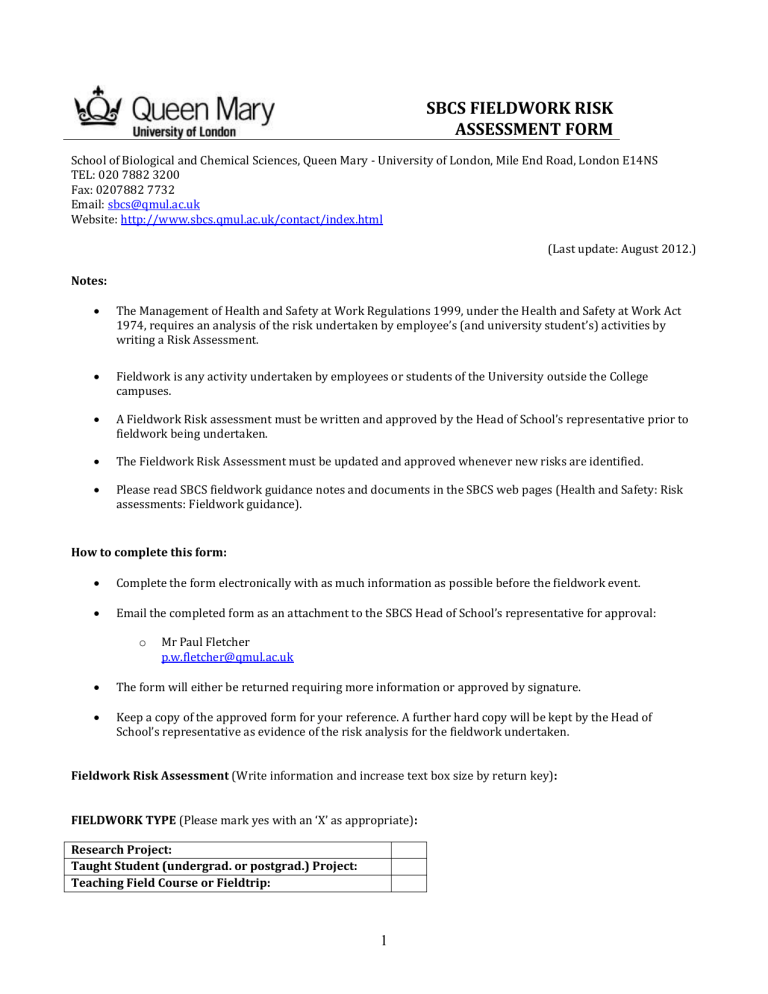
SBCS FIELDWORK RISK
ASSESSMENT FORM
School of Biological and Chemical Sciences, Queen Mary - University of London, Mile End Road, London E14NS
TEL: 020 7882 3200
Fax: 0207882 7732
Email: sbcs@qmul.ac.uk
Website: http://www.sbcs.qmul.ac.uk/contact/index.html
(Last update: August 2012.)
Notes:
The Management of Health and Safety at Work Regulations 1999, under the Health and Safety at Work Act
1974, requires an analysis of the risk undertaken by employee’s (and university student’s) activities by writing a Risk Assessment.
Fieldwork is any activity undertaken by employees or students of the University outside the College campuses.
A Fieldwork Risk assessment must be written and approved by the Head of School’s representative prior to fieldwork being undertaken.
The Fieldwork Risk Assessment must be updated and approved whenever new risks are identified.
Please read SBCS fieldwork guidance notes and documents in the SBCS web pages (Health and Safety: Risk assessments: Fieldwork guidance).
How to complete this form:
Complete the form electronically with as much information as possible before the fieldwork event.
Email the completed form as an attachment to the SBCS Head of School’s representative for approval: o Mr Paul Fletcher p.w.fletcher@qmul.ac.uk
The form will either be returned requiring more information or approved by signature.
Keep a copy of the approved form for your reference. A further hard copy will be kept by the Head of
School’s representative as evidence of the risk analysis for the fieldwork undertaken.
Fieldwork Risk Assessment (Write information and increase text box size by return key):
FIELDWORK TYPE (Please mark yes with an ‘X’ as appropriate):
Research Project:
Taught Student (undergrad. or postgrad.) Project:
Teaching Field Course or Fieldtrip:
1
BASIC DETAILS:
Fieldworker(s) included
Name Mobile phone number Status (see below) in Risk assessment
Status: Academic staff; Support staff; Research Assistant; Postdoctoral staff; Ph.D. student; Postgraduate taught student;
Undergraduate student; Other (please state).
Supervisor (if applicable):
Name Mobile phone number Status
Briefly describe the fieldwork:
Location of fieldwork:
Site Grid Reference
Dates of fieldwork:
Address and telephone number of residential base:
From To
Address of nearest emergency medical centre (e.g. A&E) to site:
Reporting-in details:
To whom Means Frequency
2
Please mark following as yes with an ‘X’ as appropriate:
All permissions and documents to work on site have been obtained:
All drivers are eligible to drive and authorised to do so by QMUL:
All fieldworkers are insured by QMUL and have the necessary documentation:
In the event of an emergency next-of-kin details are logged with SBCS administration:
In the event of an emergency a point-of-contact has been established:
All chemicals used in fieldwork have COSHH risk assessments in place:
All equipment is safe to use:
All fieldworkers are competent and trained to do the fieldwork:
Will this fieldwork involve lone working?
Your supervisor has approved the fieldwork:
Provisions for people with health problems and disabilities have been met:
Extra information attached (e.g. advice on diseases or use of field equipment).
FIELD COURSE MODULE DETAILS (IF APPLICABLE):
Module Name:
Module Code:
Course Organizer:
Number of students:
RISK ASSESSMENT:
A hazard is something with the potential to do harm, whereas the risk is the likelihood of that occurring. Here risk is rated subjectively as low, medium and high, which is related to the likelihood and severity of risk e.g. working in deep water may be high risk but may be reduced to medium or low risk if necessary precautions are taken such as use of life jackets.
Physical Hazards e.g. weather, mountains, cliffs, water bodies
Hazard Risk: Steps taken to minimise risk
Low; Medium; High
Biological Hazards e.g. infections, biting or stinging insects, poisonous plants, aggressive animals:
Hazard Risk:
Low; Medium; High
Steps taken to minimise risk
3
Chemical Hazards e.g. pollutants, contaminants, chemicals for fieldwork (use separate COSHH form).
Hazard Risk: Steps taken to minimise risk
Low; Medium; High
Man-made Hazards e.g. fieldwork equipment, electrical equipment, vehicles, power-lines.
Hazard Risk: Steps taken to minimise risk
Low; Medium; High
Personal safety hazards e.g. lone working, attack on person or property:
Hazard Risk: Steps taken to minimise risk
Low; Medium; High
Other hazards (Please specify):
Hazard Risk:
Low; Medium; High
Steps taken to minimise risk
SPECIAL PROVISIONS:
Emergency procedures (e.g. first aiders, first aid kit, survival aids, communication)
TRAVEL:
Method(s) of transport to and from site and during fieldwork.
OTHER DETAILS:
4
APPROVAL:
Person completing form:
Name
Status
Date of assessment
SBCS Head of School’s representative:
Name
Status
Date of assessment
Signature
5

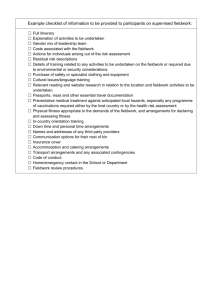
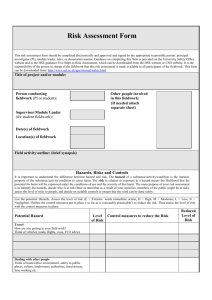
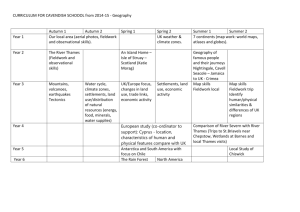
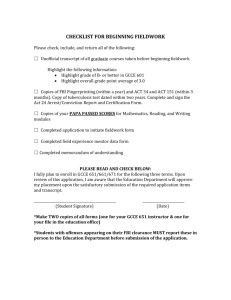
![Fieldwork Guidelines [doc]](http://s3.studylib.net/store/data/007168814_1-e9b2e04da406bf0432c39e31bfe8abff-300x300.png)